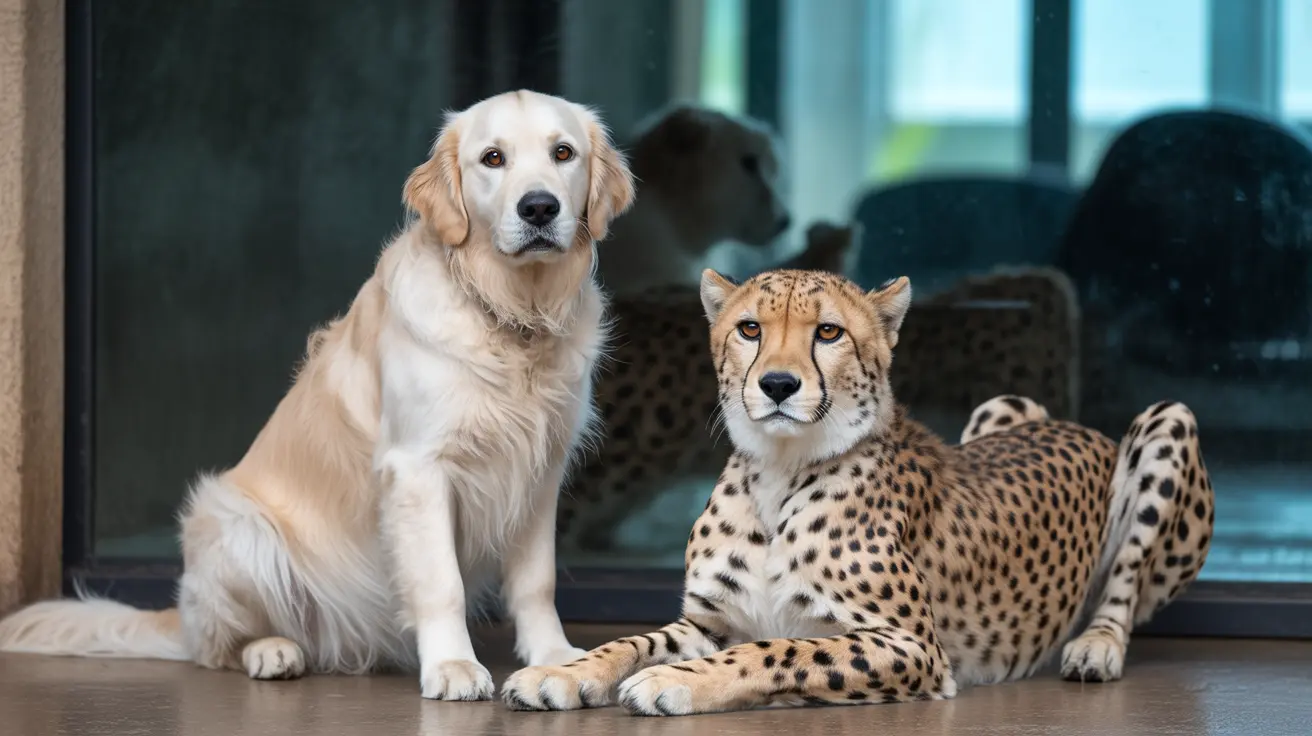In an innovative approach to wildlife care, zoos across the United States have discovered a groundbreaking solution to help their cheetah residents overcome anxiety and thrive in captivity: emotional support dogs. This unique partnership between two seemingly unlikely species has revolutionized cheetah care and conservation efforts, proving that sometimes the best friend a big cat can have is a domestic dog.
What started as an experimental program at Wildlife Safari in Oregon in 1976 has now expanded to more than 15 zoos nationwide, demonstrating remarkable success in improving cheetah welfare and breeding outcomes. The practice has become a testament to the power of cross-species companionship and innovative animal care.
The Science Behind Cheetah-Dog Partnerships
Cheetahs, despite their impressive speed and hunting prowess, are naturally anxious and sensitive animals. In captivity, this tendency toward nervousness can become amplified, affecting their overall well-being and breeding success. The presence of confident, social dogs helps regulate the cheetahs' stress responses by modeling calm, relaxed behavior.
Research has shown that cheetahs paired with emotional support dogs display lower cortisol levels, indicating reduced stress. The dogs' steady temperament serves as a behavioral blueprint, helping cheetahs navigate potentially stressful situations with greater ease.
Creating Successful Partnerships
The Introduction Process
The key to successful cheetah-dog partnerships lies in careful introduction and matching. Zoos typically begin the process when both animals are young, usually around 3-4 months old. This early introduction allows for natural bonding and the development of social connections during critical developmental periods.
The animals first observe each other through protective barriers, gradually progressing to supervised direct interactions as they show positive interest in one another. This methodical approach ensures both animals feel safe and comfortable throughout the process.
Selecting the Right Canine Companion
Not just any dog can become a cheetah's emotional support companion. Zoos carefully select breeds known for their stable temperaments and social nature. Golden Retrievers, Labrador Retrievers, and Anatolian Shepherds are among the most successful breeds in these programs, chosen for their:
- Calm and confident demeanor
- Social intelligence
- Physical robustness
- Natural friendliness
- Adaptability to new situations
Impact on Conservation and Breeding
The presence of emotional support dogs has shown remarkable effects on cheetah breeding programs. By reducing stress and anxiety, cheetahs become more likely to exhibit natural behaviors and successful breeding patterns. This improvement in reproductive success is crucial for the conservation of this vulnerable species.
Several zoos have reported significant increases in successful cheetah births following the implementation of dog companionship programs, contributing to the species' survival in captivity and potentially helping to maintain genetic diversity.
Daily Life and Interactions
The day-to-day relationship between cheetahs and their canine companions involves various activities that strengthen their bond and provide enrichment for both animals. They engage in supervised play sessions, share adjacent living spaces, and often participate in public education programs together, helping to raise awareness about conservation efforts.
Frequently Asked Questions
How do emotional support dogs help reduce anxiety in cheetahs at zoos?
Emotional support dogs provide a calming presence through their naturally confident behavior. They model relaxed responses to various situations, helping cheetahs learn to manage their anxiety. The dogs' steady temperament helps regulate the cheetahs' stress responses and provides social companionship.
What is the process for introducing a cheetah cub to an emotional support dog?
The introduction begins when both animals are around 3-4 months old. They start with visual contact through barriers, gradually progressing to supervised direct interactions. The process is carefully monitored and can take several weeks to ensure a positive relationship develops.
Which dog breeds are commonly used as emotional support animals for cheetahs, and why?
Golden Retrievers, Labrador Retrievers, and Anatolian Shepherds are commonly used due to their calm temperaments, social nature, and physical resilience. These breeds are chosen for their ability to remain steady in various situations and their natural friendliness.
Can emotional support dogs improve cheetah breeding success in captivity?
Yes, emotional support dogs can significantly improve breeding success by reducing stress levels in cheetahs. Lower anxiety levels lead to more natural behaviors and improved breeding outcomes, contributing to conservation efforts.
How do emotional support dogs and cheetahs interact and socialize during their companionship?
They engage in supervised play sessions, share adjacent living spaces, and participate in various enrichment activities together. Their interactions are always monitored by trained staff to ensure safety and positive experiences for both animals.
Through this innovative approach to animal welfare, zoos have discovered that the path to helping cheetahs thrive sometimes leads through the heart of man's best friend. The success of these programs continues to demonstrate the remarkable potential of cross-species partnerships in wildlife conservation.






